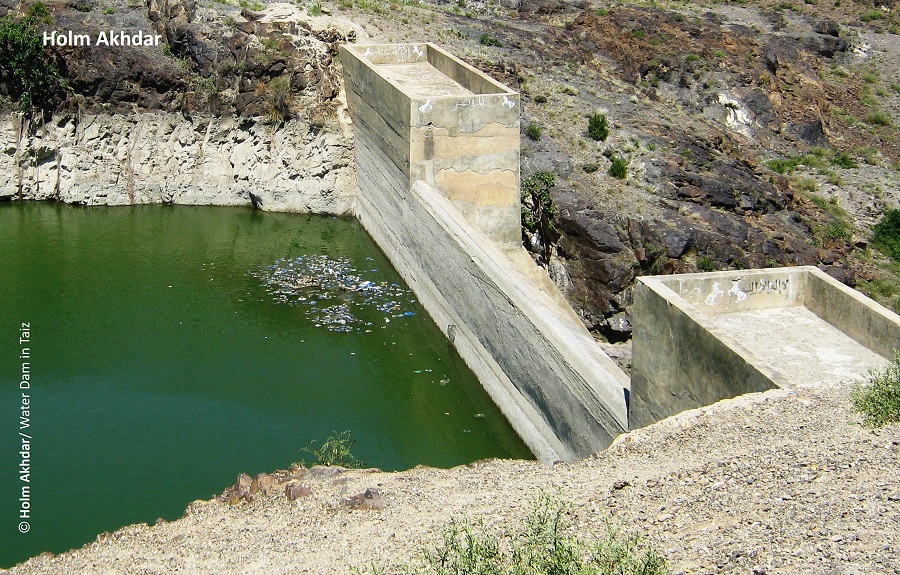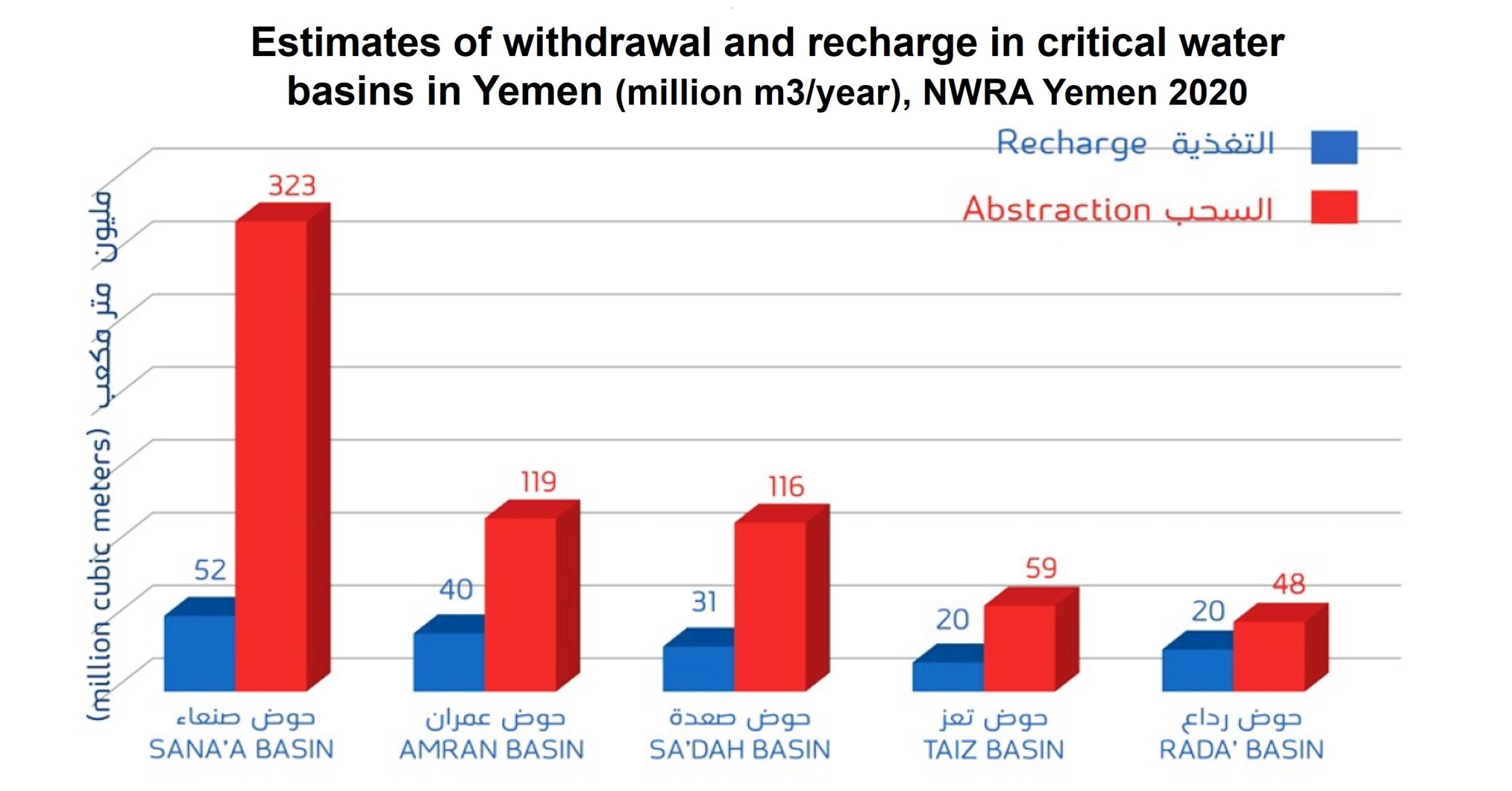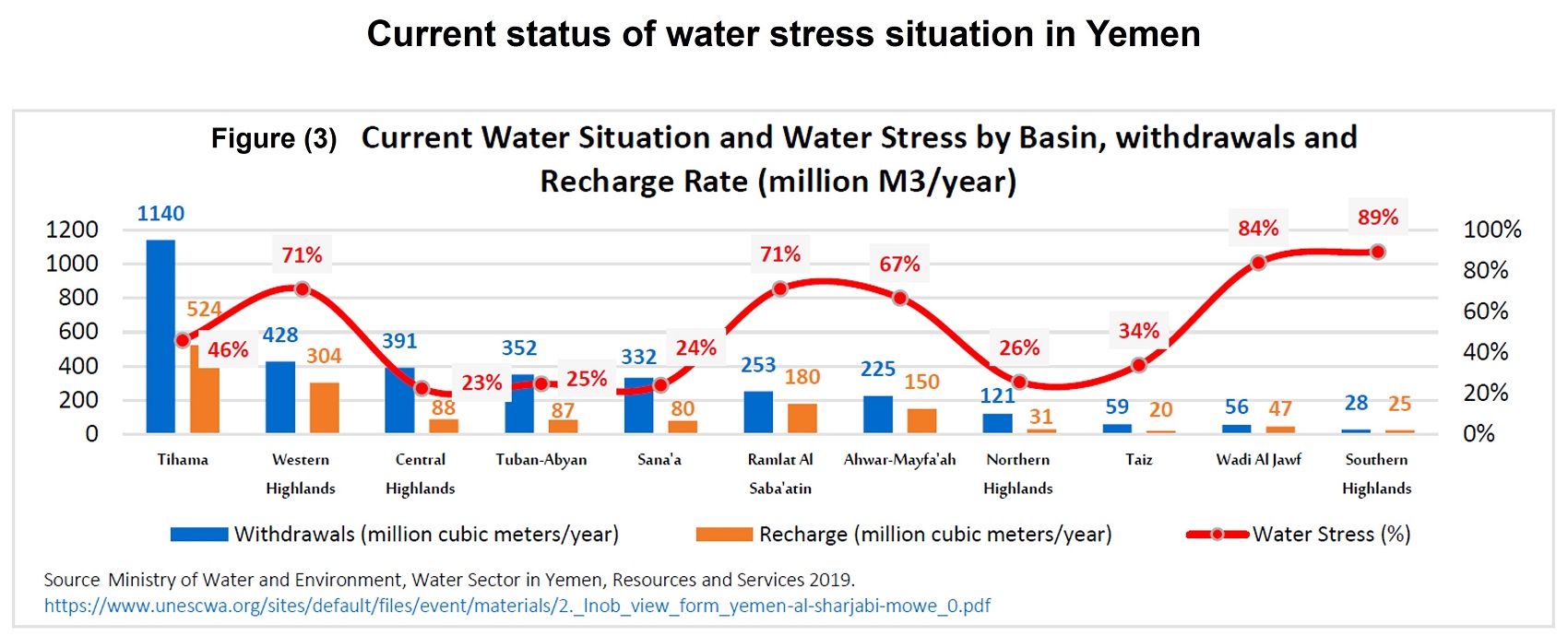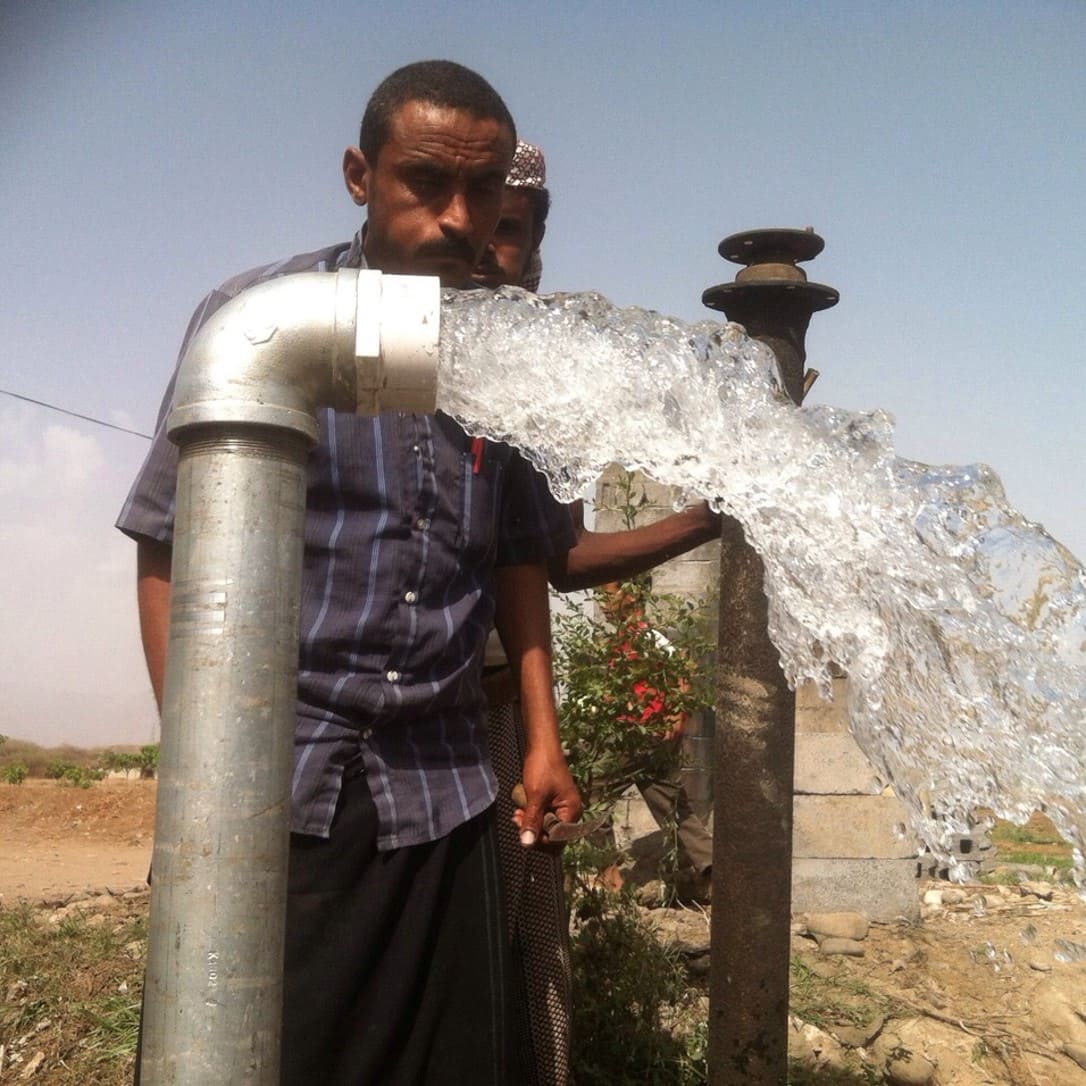By: Maha Al-Salehi *
Introduction

Yemen is situated in the northerly tropics and is mostly arid and semi-arid. Typically, high temperatures can top 40° C in many areas but decrease to temperate levels in the highland and mountainous areas where most of the food crops is produced. Rainfall is highly erratic and occurs in two periods: from March through May and more heavily from July through September.
Yemen is considered one of the most water-scarce countries in the world. Among the main threats which face the country’s water resources is groundwater depletion which adds an important challenge to water and food security.
The United Nations World Water Development Report 2022 highlighted the dire situation of groundwater status globally – including in Yemen – and aimed to draw some attention to its specific functions, challenges and opportunities around the world.
In Yemen, water resources depend mainly on groundwater and rainfall. These resources are facing a crisis which is clearly visible and considered among Yemen’s top environmental challenges today.
Yemen is currently the seventh most water-scarce country in the world [1] with dwindling groundwater levels ranging between 3 to 8 metres per year in critical basins.[2]

Current groundwater situation in Yemen
Yemen is experiencing “absolute scarcity”[3] of water resources with an average share of 82 m³ per year per capita (NWRA, 2020) which is well below the average water share in the MENA region.
The country receives limited rainfall ranging between 19 to 600 mm/ year and has no permanent rivers. Thus, overexploitation of groundwater resources has been on the rise to respond to the different water needs.
According to an interview conducted by Holm Akhdar with the National Water Resources Authority (NWRA), estimates of water use in 2020 were: 80.4% for agriculture to irrigate a total area of 0.52 million hectares (with 32% coming from groundwater), 14% for domestic use and 5.6% for industrial use mainly in the food, chemical, pharmaceutical and beverage industries.

Regarding Yemen’s renewable water resources, they reach 2.5 billion cubic meter/year while used water is 5.1 billion cubic meters/year; this reflects an alarming water deficit situation of around 2.6 billion cubic meters/year (NWRA, 2019).
The groundwater withdrawal rate is currently more than twice the recharge ratio with a presence of more than 800 rigs and more than 100,000 wells most of which were drilled illegally (NWRA, 2021).
Random #water wells drilling in #Yemen:
Infographic pic.twitter.com/s4ZZTgCDxH
— حلم أخضر Holm Akhdar (@holmakhdar) March 11, 2020
These patterns of groundwater extraction are leading to the depletion of water reserves and are causing negative socio-economic consequences.
In some critical basins of Yemen, groundwater is being depleted at a rate that greatly exceeds the recharge rate, and if the extraction continues at the same level, it could be less than 20 years for all groundwater sources in Yemen to dry out (UNDP & FAO, 2020).[4]
Among the 15 water basins in Yemen, 5 are classified as critical, which have recorded the highest drop in groundwater levels as a result of low basin recharge and high extraction rate in Sana’a Basin, the water deficit reached (271 million m3 per year), in Sa’dah basin (85 million m3 per year), in Amran basin (79 million m3 per year), and in Taiz basin (39 million m 3 per year), while the water deficit in Rada’ Basin amounted to (28 million m3 per year).[5]
These basins face pressures in terms of quantity and quality, for example the demand for water in Sana’a Basin exceeds the supply by more than four times [6], additionally, different contaminants from hazardous waste are infiltrating aquifers in different regions in Shabwa, Southern in Yemen, which pollute the wells and surface water.

By looking at the current situation of water stress in Yemen, alarming levels of water stress emerge in the various basins in the country. Four basins suffer from water stress: Tibn – Abyan, Sana’a, the northern highlands and the central highlands, with water stress levels ranging between 23% – 26%.
Furthermore, Tihama and Taiz basins suffer from critical water stress of 46% and 34%, respectively. On the other hand, 5 basins suffer from very critical water stress: the western highlands, Ramlet al-Saba’in, Ahwar-Mayfa’a, Wadi al-Jawf, and the southern highlands, ranging from 67% – 89%.[7]

There are many reasons behind the deterioration of groundwater status in Yemen which include water resource scarcity, rapid population growth, climate change, poor water governance and infrastructure, overexploitation especially with the continuous and increasing illegal drilling, the introduction of deep-well drilling pumps and water quality degradation.
Moreover, water facilities have been targeted during the ongoing conflict which have added a burden on groundwater sources and impacted water sanitation and hygiene (WASH) services as a whole; this has put around 15.4 million people in urgent need for safe water and sanitation.[8]

Climate change and groundwater availability
Climate and the terrestrial water cycle have a very close and complex relationship where changes in climate variability impact water resources.[9]
In Yemen, climate change is affecting three key areas: water resources, agriculture, and coastal zones.[10] It has intensified the variation in precipitation distribution and resulted in severe impacts such as extreme flooding, droughts, desertification, increased storm frequency/severity and sea level rise which have caused significant human, economic and agricultural losses.
When it comes to groundwater, climate change is influencing the recharging of aquifers due to the changes in the precipitation in terms of amount and distribution. This has put groundwater salinity at a higher risk due to sea level rise.
In addition, groundwater and surface water wells (artesian and traditional) may be exposed to direct pollution as a result of floods, especially if they are loaded with wastewater and other pollutants.
In a World Bank report [11] which assesses the impacts of climate change and variability on water and agriculture in Yemen, three climate scenarios are described: “Dry and Hot”, “Mid” and “Warm and Wet” scenarios.
The study suggested that by 2100 the average temperature would increase by 1.6° C in the best-case scenario and 4.5° C in the worst-case scenario. The projections expect a 24% decline of precipitation in the worst-case scenario and a 13% increase in the best-case scenario by 2080 (World Bank, 2010).
Due to the increased frequency and intensity of extreme events, the availability of meteorological data is essential to enhance the monitoring of climate variations and their effects as well as the activation of early warning systems. Based on Holm Akhdar’s interview with the NWRA, the Yemeni Hydrometeorology Monitoring Network has been significantly damaged during the conflict. The Authority has noted that around 81% of the network stations are not operating. (NWRA, 2021).

Groundwater governance and gaps
Water governance in Yemen is mainly managed by the National Water Resources Authority (NWRA), a unit of the Ministry of Water and Environment.
NWRA formulates water strategies, policies and plans in a decentralised approach to implement Integrated Water Resource Management. Based on the 2002 Water Law, which was amended in 2006, NWRA is the only governmental body responsible for managing water resources including exploiting, developing and protecting them from depletion and pollution.
The Water Law aims to establish a legal basis for regulating groundwater extraction through the identification of measures such as licensing and registration requirements for wells. Despite the importance of this law and the objectives of NWRA, the weakness of water legislation and infrastructure, the poor participation of local councils and communities in water conservation and the current absence of a holistic approach in water management have hindered government institutions’ ability to prevent the illegal drilling of water wells.
Also, the lack of strict government regulation and enforcement has made it possible for some members of the prominent privileged class, such as government representatives and tribal leaders (sheiks), to participate in illegal drilling of their own wells with impunity causing a nearly total privatisation of Yemen’s water resources. [12]
Consequently, many Yemenis receive their water from private tanker-truck suppliers who purchase water from wells owners. Others who cannot afford this expensive solution tend to fetch water, which has been a daily struggle for millions of women and children across the country[13] even prior the conflict. Fetching water could take long hours and expose the lives of women and children to danger.
For instance, on April 12th, 2022, a tank vehicle in Al-Jahmalia neighbourhood Taiz ran over 7 women and children while they were collecting water, causing casualties. [14]
During the interview of Holm Akhdar with NWRA, several gaps in water governance were stated including the unavailability of water data, lack of equipment and tools, the absence of specific training and qualification, weak institutional structure and incomplete technical studies.

It was also mentioned that some technical data of basins has not been updated for 16 years. Additionally, international organizations which work on projects related to water resources do not coordinate with NWRA nor do they build upon the local water strategies such as the National Water Strategy and Investment Programme (NWSSIP).
These activities have led to some imbalances which could have been avoided when collaborating with the NWRA.
An important example is manifested with the solar-powered pumps which have been provided to farmers by some International Non-Governmental Organisations (INGOs) and several reports have illustrated the misuse of these pumps which resulted in over extraction of groundwater.
Possible solutions
The groundwater situation in Yemen requires immediate and collective action from all stakeholders (governmental actors (NWRA), local organisations and committees, the private sector and international actors (INGOs)) to ensure a better and integrated management of water resources before critical basins run out of water.
There are many solutions which can be implemented to prevent a catastrophic scenario, these include the following:
- Facilitating water access and delivery to respond to the dire needs of clean drinking water and sanitation services. However, a mixed paradigm between emergency and development projects and initiatives is highly needed to ensure sustainability and long-terms solutions.
- Preparing a national strategy for the management and development of water resources. This shall be accompanied by activating the water law as well as the regulations and decisions related to the management and protection of water resources from depletion and pollution. Coordination between the national, local and international actors is highly needed. Also, sovereign authorities are required to prevent illegal well drilling and groundwater misuse otherwise water policies will not be effective.
- Updating of the National Water Resources Management Information System (NWRMIS) as well as data and studies in relation to water basins and areas.
- Improving unconventional water resources such as rainwater harvesting and wastewater reuse to relieve pressures on groundwater.
- Training farmers in using modern methods and techniques to irrigate crops efficiently and in shifting to high-value, rain-fed and drought-resistant crops. Tools which exacerbate the depletion of groundwater, such as solar-powered pumps provided to individual farmers, should be halted and be offered to farming associations under supervision instead.
- Restoring water infrastructure damaged by climate shocks and/or conflict including the Hydroclimate Monitoring Network. Also, building new structures for water collection to decrease groundwater extraction rates (e.g. small dams).
Finally, Holm Akhdar would like to insist on calling all concerned stakeholders to urgently declare a climate emergency in Yemen and to prepare a unified national plan to confront climate disasters and establish a national centre for climate emergency and early warning.
This plan shall consider sustainable ways to manage water amid extreme events as one of its main pillars.
#Yemen urgently needs to:
– adopt different environmental, comprehensive and equitable policies to manage the risks of increasing natural disasters.
– draw up a climate-change contingency plan.
– establish a national center for climate emergencies.
– declare a climate emergency. pic.twitter.com/NXc4RDRZCc— حلم أخضر Holm Akhdar (@holmakhdar) August 28, 2020
*Maha Al-Salehi: is a Researcher Fellow with Holm Akhdar Environmental foundation, where she focuses on topics related to water, climate change and the environmental challenges in Yemen.
References:
[1] According to “Water availability in Yemen: Literature review of the current and future water resources and water demand in Yemen” by Acacia Water (2021)
[2] Holm Akhdar interview with National Water Resources Authority, Yemen. 2022.
[3] An area is experiencing water stress when annual water supplies drop below 1,700 m3 per person. When annual water supplies drop below 1,000 m3 per person, the population faces water scarcity, and below 500 cubic metres “absolute scarcity”. [link]
[4] According to “Water availability in Yemen: Literature review of the current and future water resources and water demand in Yemen” by Acacia Water (2021)
[5] Holm Akhdar interview with NWRA, estimates of the year 2020.
[6] Holm Akhdar interview with NWRA.
[7] Ministry of Planning and International Cooperation, “Yemen’s Water Crisis Threatens Water Security,” Economic Update Bulletin, Sana’a, Issue (61) June 2021.
[8] Lack of clean water far deadlier than violence in war-torn countries, says UNICEF report, United Nations, 2021 [link]
[9] “Addressing the challenge of extreme water scarcity for reconstruction and beyond”, World Bank, 2017 [link]
[10] Climate change adaptation – Yemen, UNDP [link]
[11] Yemen: Assessing the Impacts of Climate Change and Variability on the Water and Agricultural Sectors and the Policy Implications, WBG, 22 April 2010 [link]
[12] The time to act on Yemen’s water crisis is now, Yemen Policy Center, 2021 [link]
[13] According to the UNDP, only 22% of rural and 46% of urban populations are connected to partially operating public water networks. Less than 55% of the population has access to safe drinking water [link]
[14] Because of the water crisis, 7 people were killed and injured in the city of Taiz, Taiz Today, 2022 [link]
